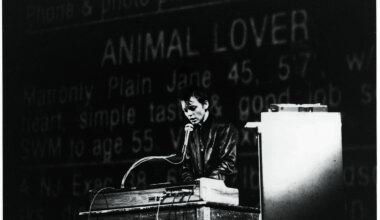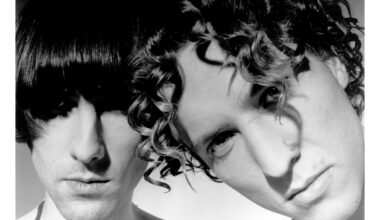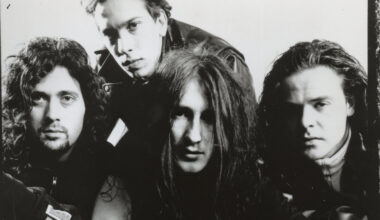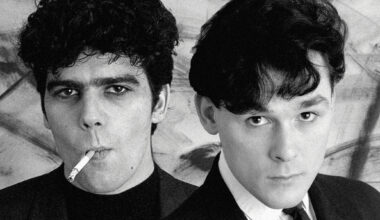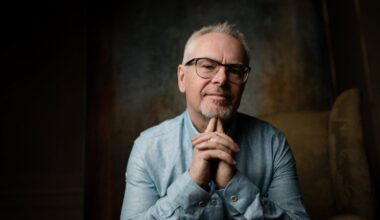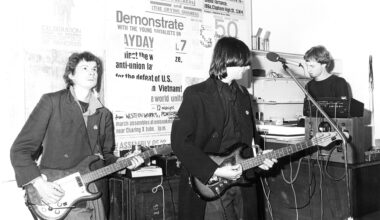The Woodentops’ Rolo McGinty talks us through the 1985 belter and monster crossover Ibizan floorfiller ‘Why Why Why’

“I had the basics of the music – guitar, bass, drums and keyboards – and it sounded like technological Afrobeat with a touch of reggae. ‘Why Why Why’ was temporarily called ‘Africa Satellite’, and was going round developing in the flat for a couple of weeks as I would get other ideas, little details. When I added my guitar it became something else, more flamenco perhaps.
“So I took it to the rehearsal room and everybody learnt the parts. Immediately, we loved it, and soon it became a favourite to play. One day when we were rehearsing, it had more of an urgency, and the title ‘Why Why Why’ came to mind. It just came out of my mouth in one of the jams.
“At the time, the Iran-Iraq War was kicking off, and that sparked the whole lyrical thing. The song itself is utter neurosis based on fact, but slipped into poetry mode, all current day nausea and future worry. The verses came quickly: there was a roll of lining paper with so much written on it, many of the verses had to be cut out, as I had way too much. There was an anxiety to it, about the world in general – the nuclear crisis, starvation, a disastrous future ahead. So the song had its meaning. To think it became a club anthem is quite bizarre.
“It was Christmas 1985 and the band had worked super hard all that year, so I suggested that if anybody wanted to contribute a verse and perhaps sing it too, I would include them in the writer royalty. Benny [Staples] and Simon [Mawby] came up with something, so that’s why three names appear on the song’s credits. The song was demoed, and then mixed by Adrian Sherwood.
“We used to have Adrian’s On-U Sound records, CDs and tapes playing constantly at home, and on the tour bus. When we were touring to promote the early singles, I remember John Botting, one of our crew who drove and mixed our sound, saying that he hated it when we played that stuff, because he couldn’t tell what were road sounds and what was the noise in Sherwood’s dubs. It made him paranoid.
“Anyway, we asked Adrian if we could send him some music, and it was arranged for me to go and meet him. I was a bit nervous, but as soon as I arrived he asked, ‘Do you play bass?’. When I said that I did, he asked me if I could do a bass part on a keyboard and we got stuck in right away on a piece with football commentary and a crowd singing anthems, roaring at goals.
“Adrian hummed the idea into my ear for a bit to get me started and I recorded it live on a Fairlight that belonged to Al Jourgensen from Ministry. It was the first time I’d even seen one. That track was later named ‘Sharp As A Needle’. So on the day I met Adrian I became part of the Barmy Army. Adrian agreed to do a few mixes of ‘Why Why Why’. There was one for Record Mirror, who put it out as a 45 with the magazine, and another for the ‘Everyday Living’ single B-side.
“Every time we performed the song live, it changed, evolved. The tempo sped up, and the beat and percussion became more prominent. Benny played a drum intro alongside his Roland 909, with the percussion running as a sequence – woodblocks through reverb and the ‘chink chink’ of the Mercedes-Benz hub caps he had in his kit. We had two keyboard players, Sonia [Waters] and Anne [Stephenson], who also played violin on it.
“We ran out of time while recording the ‘Giant’ album and so ‘Why Why Why’ was left unfinished, in a state of flux, but it did get included on the ‘Live Hypnobeat Live’ album. It’s this version that became the ‘Balearic beat’ hit in Ibiza.
“‘Live Hypnobeat Live’ was recorded live at the Palace Theatre, Los Angeles, in 1986. Prior to hitting the stage, we’d all taken ecstasy. It was our first time, so it was a stand-out night for us. We pretty much forgot we were recording live for the KROQ radio station and really went for it. We had no reason to think that the recording would end up as an album. I clearly remember the bizarre sight of Donny Osmond and a camera crew wading through the crowd. He was having a documentary filmed about him, and large silver lighting umbrellas, cameras and lights followed him. So his entrance at the back there was pretty high profile. All I could see was a large white blur. In the song ‘Move Me’ you can hear me saying, ‘What is that?’.
“‘Why Why Why’ started pretty much the same as every night, but on this occasion I remember it feeling really, really good about halfway through. It was hard to get the words out too. The concert was fierce, and it took ages to adjust to afterwards. Immediately after the gig I had a live phone interview with the radio station, and I could hardly throw a sentence together. I think that was my most nuts interview ever. I felt like a boxer being publicly questioned after a near knockout match.
“The after-show shenanigans began with a visit from all the US record company guys, and we tried to be polite, but we were altered. Then Donny Osmond came in and I got to talk with him. He was really into talking about electronic music. It was utterly surreal to be chatting to somebody who’d been on TV all through my teens.
“We really let go after the show. We all had red eyes and had begun hitting the backstage bar. There was a photo taken of Donny, us, and the record company guys. We look trashed. Hardly surprising.
“This was around the end-point of us getting on really well, and there being an easy-going relationship between us. It was the end of a whole year of touring. Wonderful though that is, tiredness adds up. The stress of entertaining all those people who have paid so much to get a ticket, the responsibility of having good people on the payroll, wanting to be better and better.
“After that tour the first musician changes in years happened, so for me the live album is the final document of that classic line up at a peak, happy time. Truth be told, ‘Why Why Why’ was the band’s own party tune. In rehearsals, we would shut the doors and dance our legs off.”
